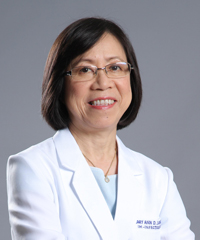More than anything about her childhood in the Philippines, Mary Ann Lansang loved learning. From primary school in her hometown of Baguio, a small city in the mountains of Luzon, to college in the capital, Manila, Lansang was a standout student for whom subjects like science and math were nothing but fun.
 Photo provided by Mary Ann Lansang | "The word ‘nerd’ had not been invented in the 1960s,” she says, “but I guess that is what I was.” And it was this love of learning that led her to become a renown professor of medicine and clinical epidemiology at the University of the Philippines and the former deputy director of the Research Institute for Tropical Medicine (RITM), the country’s foremost medical research facility. |
Helping to eliminate malaria
During medical school, Lansang developed a fondness for the study of infectious diseases, particularly malaria. Thanks to the concerted efforts of the Philippines’ National Malaria Control Program, the country may soon be able to declare itself malaria-free. But at that time, she says, “malaria was a much bigger problem,” and Lansang, for one, was well equipped to address it. She had her MD, of course. With support from the Rockefeller Foundation, she went on to earn a master’s degree in clinical epidemiology – “a happy marriage of clinical medicine and public health” – from the University of Newcastle in Australia.
You treat the individual, but you also have to understand how he or she interfaces with the larger community.
- Mary Ann Lansang
Lansang focused on community-based approaches to disease control. As a clinical epidemiologist, she says, “you treat the individual, but you also have to understand how he or she interfaces with the larger community.” Battling malaria, she recalls, was a career defining experience, and not only for what it taught her about the disease; through collaboration with research institutions in other countries, Lansang learned for the first time, she says, about TDR and its capacity strengthening activities. “That was a very stimulating time for me.”
Building networks
Lansang’s second encounter with TDR came through her early involvement with the International Clinical Epidemiology Network (ICLEN), of which she would later serve as executive director. That group’s annual meetings brought her to the attention of Dr Richard Morrow, the late head of epidemiology at TDR, who was then managing a new TDR capacity building initiative called Field Links for Intervention and Control Studies (FIELDLINCS).
It can be very lonely out there, especially for those scientists studying tropical diseases, where you often don’t have a good research environment. FIELDLINCS got us talking with each other.
- Mary Ann Lansang
Designed to promote high quality field research on TDR diseases – malaria, schistosomiasis, filariasis, trypanosomiasis, leishmaniasis and leprosy – FIELDLINCS aimed to link scientists from institutions that receive grants through TDR’s research capability strengthening component with recipients of TDR grants in support of research and development of new drugs and diagnostics. The hope was that this would not only strengthen research capacity in disease endemic countries but also encourage collaboration among those countries as well as with researchers in high-income countries – mitigating the feeling of isolation frequently reported by researchers in the field.
In 1990, Morrow recruited Lansang to spend a year in Geneva overseeing the FIELDLINCS program from TDR headquarters. “It can be very lonely out there, especially for those scientists studying tropical diseases, where you often don’t have a good research environment,” she recalls. “FIELDLINCS got us talking with each other. We had regional networking meetings, and we published a newsletter, since at that time the Internet was just coming into use.”
Following her return to Manila in 1991, Lansang deepened her involvement in tropical disease research. Even after being appointed deputy director of RITM, she continued to plan and implement large projects, mainly in the area of community-based malaria control, tuberculosis and vaccine-preventable diseases. When a clinical epidemiology unit was established at the University of the Philippines, Lansang became its first director, all the while maintaining her post in the department of Medicine, where she served as chief of Infectious Diseases.
Mentoring and working with new generations
In addition to her teaching responsibilities, Lansang served on a number of international boards and advisory committees, including two of TDR’s scientific committees: the Steering Committee on Vaccine Discovery Research, from 1995 to 2000, and the Scientific and Technical Advisory Committee (STAC), from 2001 to 2007, bringing to both the vital on-the-ground perspective. In 2000, Lansang also assisted TDR efforts to facilitate the development of promising interventions and products by ensuring that Phase 1-2 malaria vaccine trials supported by TDR adhered to the requirements of Good Clinical Practice (GCP).
And yet somehow, Lansang still found time to mentor young researchers, which she says has always been part of her work, both at RITM and at the University. “Watching those young researchers grow into public health professionals and advance in their own careers, that’s the most satisfying thing,” she says. “I now stand side-by-side and work hand-in-hand with some of those students I mentored in the past. And they will carry on long after I've retired.”
Mary Ann Lansang is a member of TDR Global, a platform for research networking. She has offered to be a mentor; you can find out more about her and the many other TDR Global members here. If you’d like to contact Mary Ann, you can email her at: mlansang@gmail.com.
For more information, contact
Makiko Kitamura, TDR Communications Officer, Telephone: +41 22 791 2926, email: kitamuram@who.int

